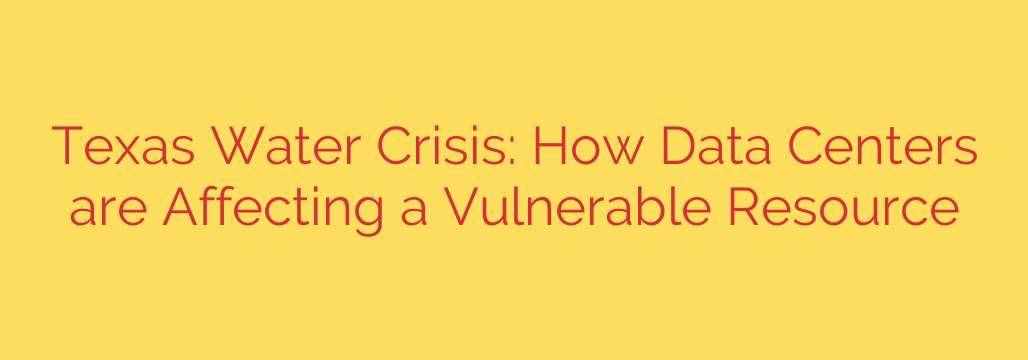
The Unseen Cost of the Cloud: How Data Centers Are Impacting the Texas Water Supply
Texas is at the center of a technological revolution. A massive influx of tech companies and data centers is transforming the state into a global digital hub. But this boom comes with a hidden cost, one that taps directly into the state’s most vulnerable resource: water. As Texas grapples with recurring droughts and a growing population, the immense thirst of the digital age is putting unprecedented strain on its water supplies.
At the heart of our online world—from streaming movies and social media to the complex calculations of artificial intelligence—are data centers. These facilities are filled with thousands of powerful computer servers that generate an incredible amount of heat. To prevent overheating and keep the digital world running smoothly, these servers must be constantly cooled.
While there are several ways to cool a data center, one of the most common and cost-effective methods is evaporative cooling. This process uses water, which is evaporated into the air to dissipate heat—think of it as a massive, high-tech swamp cooler. The downside is that this method consumes a staggering amount of water.
The Scale of the Problem
The numbers are difficult to comprehend. A single, large data center can consume millions of gallons of water every single day. To put that in perspective, the daily water usage of one facility can be equivalent to that of a small city.
This issue is becoming more urgent for several key reasons:
- The Texas Tech Boom: The state’s business-friendly environment, vast land, and robust energy grid have made it a magnet for tech investment. New data centers are being built at an astonishing rate, particularly in major hubs like Dallas-Fort Worth and Austin.
- The Rise of AI: The development of artificial intelligence requires even more powerful processors that generate more heat. As AI becomes more integrated into our lives, the energy and water demands of the data centers that power it will only skyrocket.
- Lack of Transparency: Many tech companies are notoriously secretive about their resource consumption, often citing proprietary business reasons. This makes it incredibly difficult for local officials and residents to understand the true impact these facilities are having on their water supplies.
A Growing Strain on Local Communities
In a state where water is already a contentious issue, the arrival of these thirsty industrial consumers creates a serious dilemma. Many Texas communities are already facing water restrictions during dry periods, with residents being asked to limit lawn watering and other non-essential uses.
The conflict arises when residents are asked to conserve while a single facility down the road is permitted to draw millions of gallons of water from the same source. This dynamic places immense pressure on municipal water systems, especially in smaller towns that may not have the infrastructure or resources to support both a growing population and massive industrial water users.
Finding a More Sustainable Path Forward
Addressing this challenge isn’t about halting technological progress. Instead, it’s about pushing the industry toward more responsible and sustainable practices. Fortunately, solutions and more efficient technologies already exist.
Actionable steps for a more water-wise tech industry include:
- Adopting Closed-Loop Cooling: Unlike evaporative systems that constantly consume and lose water, closed-loop systems chill and recirculate the same water continuously. This drastically reduces overall water consumption.
- Exploring Liquid Immersion Cooling: A cutting-edge technology where servers are submerged in a non-conductive dielectric fluid. This method is highly efficient and uses virtually no water for cooling.
- Utilizing Non-Potable Water: Data centers can be designed to use recycled or reclaimed water (often called “gray water”) for their cooling needs, preserving precious drinking water for communities.
- Increasing Transparency and Accountability: Tech companies must be more forthcoming about their water and energy usage. This allows for better regional planning and holds companies accountable for their environmental footprint.
As Texas continues to lead the way in technological innovation, it must also lead in environmental stewardship. The conversation about the state’s future can no longer separate economic growth from resource management. Balancing the needs of the digital age with the preservation of our most essential natural resource will be the defining challenge for Texas in the years to come. The cloud may be virtual, but its impact on our water is very real.
Source: https://www.datacenters.com/news/texas-water-crisis-the-impact-of-data-center-developments-on-a-fragile-resource








